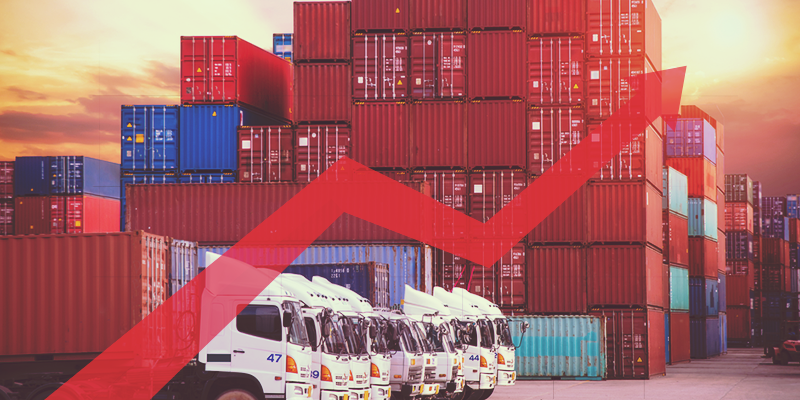How efficient logistics impacts your business
Would you like to increase operational efficiency, better utilise on-field resources, increase vehicle utilisation, serve more customers, and improve customer satisfaction? Efficient logistics management is the core differentiator in defining the success of many businesses. Increasing customer expectations and doorstep deliveries only add to the complexities of the supply chain processes. New-age deep tech companies in the logistics space are offering a range of value-added services to fulfil the demand.

Image credit: Shutterstock
As logistics and transportation expenses take a larger bite out of every sales dollar, companies continually analyse this expense relationship to their overall cost of doing business. Logistical expenses typically make up 8–10 percent of total costs for a firm, so most organisations try to tame the complex operations by deploying technology tools. With an automated, cost-effective logistics system, a company can implement major strategic changes and improve operational efficiency. It also improves scalability, reduces manual errors, and provides a proactive approach to customer satisfaction. The emergence of SaaS providers for logistics automation has made this considerably more affordable and easier than ever before.
Corporate managers traditionally have viewed logistics as a mandatory cost bucket. However, top-performing companies like Amazon now recognise that mastering supply chain operations can be more than that: it can be the source of competitive advantage.
Factors to be considered to save cost and time:
- Customer satisfaction: Customer loyalty becomes critical, as it costs five times more on an average to acquire a customer than to retain one. Keeping customers happy requires the per-order cost of logistics to be low. By maintaining customer satisfaction, companies can keep business up and therefore, spread out the cost of logistics support over a greater number of orders/customers. Because of this direct correlation between customer satisfaction and overall cost reduction, customer service should be factored into any measurement of changes in logistics costs accordingly. When the appropriate tools to manage complexity are in place, organisations have greater opportunities to continuously create operational efficiencies and keep customers happy.
- Labour costs: Every project should be seen through the prism of labour costs and attrition rates. Incentive programmes for field executives, if well structured, really work in reducing both. Automation platforms which provide end-to-end performance measurements in terms of distance travelled, number of tasks completed, time on road and transaction time can help in creating the much needed incentive programmes for employees.
- Going green: Today, companies need to look at how they can cut costs by going greener. For logistics, this is possible by reducing fuel consumption and the overall fuel costs by streamlining routes and changing bad driver habits (like long idles), which is again linked to the performance of the drivers.
- Faster processing and delivery: This leads to more satisfied customers and lower inventory carrying cost. Response time is an increasingly important strategic weapon in the arena of competition. Leading companies seek to respond to orders in minimum time as delay costs directly affect prices, operating policies, sales, and the firm’s profits in a competitive environment. These time-based strategies can be dealt with through the use of technological innovations. In an era of free shipping, one-hour delivery, and drone drops, customers have high expectations about efficient product delivery. Amazon reported a 51-percent increase in Prime memberships in 2016.
- Failed deliveries: This increases the costs for retailers, both in redelivery fees and the administrative burden of rescheduling deliveries and finding accurate addresses. It also results in unhappy customers who are unlikely to return to your site, and who can hurt your brand's reputation. First-time delivery rates can be as low as 80 percent, which can be a massive waste of time and money for the retailer, as well as a hassle for the customer. A strong geocoder contributes to increased business and operational efficiencies. It also helps keep package delivery costs down by reducing the fees that many postal operators charge for failed deliveries.
In 2005, Walmart committed to a momentous goal: doubling the efficiency of their fleet by the end of 2015. By working with their associates to establish more efficient techniques for loading, routing, and driving, as well as through collaboration with manufacturers on new technologies, they achieved this goal. With new efficiencies, their year-end results were a 102.2 percent improvement over the 2005 baseline, with associated savings of nearly $1 billion annually. This is the power of technology. The most effective strategy combines process, analytics, and technology to simplify logistics networks, mitigate risk, and optimise the associated costs.
The selection of technology must be driven by the tool's potential to:
- Simplify processes (reduce hand-offs and automate process steps)
- Expedite exception handling (take action on exceptions through alerts)
- Reduce systems complexity (for better workflows)
When companies take full advantage of the opportunities provided by these trends to invest in digital tools that drive progress, investment capital is no longer the key differentiator in gaining a competitive advantage. That’s why data-driven startups are disrupting decades-old industries and shaking up logistics management like never before.
(Disclaimer: The views and opinions expressed in this article are those of the author and do not necessarily reflect the views of YourStory.)










![[Funding alert] Accel Partners leads Rs 27 Cr pre-Series A round in debt resolution startup Credgenics](https://images.yourstory.com/cs/2/11718bd02d6d11e9aa979329348d4c3e/Imageeukn-1606192940102.jpg)
